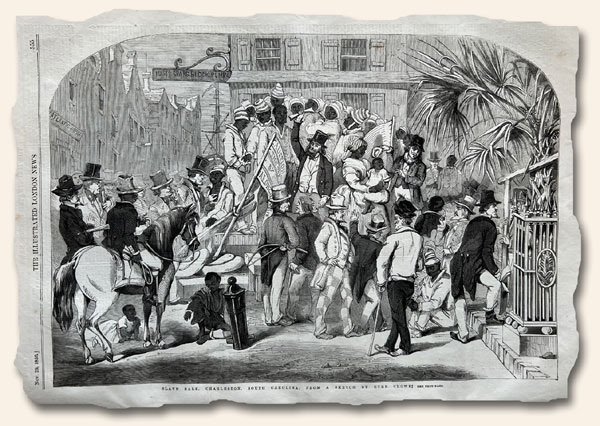The Illustrated London News… Beautiful imagery…
September 16, 2022 by LauraH · Leave a Comment
 Today, as I was searching for an issue for a collector, I was paging through an 1857 issue of The Illustrated London News. In the midst of all of the intricate black and white sketches I happened upon two full-color double page portraits of what I believed to be women’s fashion of the day… one titled “Town” and the other titled “Country”. Of course, my immediate thought went to the popular American magazine which began in the 1800’s. However, upon a bit of investigating, I found that the current Town and Country Magazine had a predecessor two hundred years prior to its inception (some of which we have sold). This English version which began in the 1760’s is described as follows by Wikipedia:
Today, as I was searching for an issue for a collector, I was paging through an 1857 issue of The Illustrated London News. In the midst of all of the intricate black and white sketches I happened upon two full-color double page portraits of what I believed to be women’s fashion of the day… one titled “Town” and the other titled “Country”. Of course, my immediate thought went to the popular American magazine which began in the 1800’s. However, upon a bit of investigating, I found that the current Town and Country Magazine had a predecessor two hundred years prior to its inception (some of which we have sold). This English version which began in the 1760’s is described as follows by Wikipedia:
“Town and Country Magazine was an 18th-century London-based publication that featured tales of scandals and affairs between members of London’s upper classes. Town and Country Magazine was founded by Archibald Hamilton in 1769. It gained the name ‘Town and Country’ because Hamilton had two offices, one in urban Clerkenwell and one in a rural area near Highgate. In the 1770s there was a dramatic increase in suits brought by men and their wives’ lovers in England. Many people became eager to read transcripts of adultery trials…”.
Yikes! After reading this, I am no longer sure what I found was describing women’s fashion.
Take a Closer Look … The Delicate Details of Woodcut Prints…
April 14, 2022 by LauraH · 1 Comment
I have had some fascinating conversations this past year with one of our collecting friends who is an expert in woodcut prints. I won’t be a name dropper, however, if he is reading this, he will have no doubt as to who I am referencing. I greatly appreciate the time he took to share his knowledge which has motivated me to pause and look more carefully at every print I encounter in the RareNewspapers archives. My proficiency in this area is sparse and not terribly reliable but I did want to share a few takeaways.
Some artists of woodcut prints would draw on paper and send the illustration to a publisher who would cut the paper into tiny square blocks and have each one sketched onto a square block of wood. These wooden squares would be handed out to different craftsmen who would carve their block and then the blocks would be rejoined for printing. Sometimes, when time was of the essence, each craftsman would use carving tools which could create many tiny lines at once. If you look closely at many such illustrations, you can tell these prints have hundreds of parallel lines – indicating the use of these tools. Occasionally, when more time was available, each line was formed individually – a painstaking process, but one which produced an almost unimaginable degree of detail!
Some artists preferred to draw their own prints directly onto the wood and so they were sent a group of one-inch square pieces bound together with twine. When the artist had finished their drawing, the publisher would untie the pieces and distribute the blocks to the woodcarvers.
Regardless of how each print was created, the detail, craftsmanship and artistic skill needed to produce one illustration is mind blowing. So, the next time you glance through a Harper’s Weekly, Leslie’s Illustrated , Illustrated London News, or handful of other illustrated titles of the “woodcut era”, perhaps you will join me in pausing and giving a bit of deference to these creators of beauty. Thanks Bill for sharing this delightful insight with me.
Frederic Remington Prints on Pinterest…
May 25, 2012 by GuyHeilenman · Leave a Comment
 Frederic Remington is known for his work depicting the American Wild West. Many of his prints made their way onto the pages of Harper’s Weekly, the premier illustrated newspaper of the 19th and early 20th centuries, along with a handful of other publications of the period. Timothy Hughes Rare & Early Newspapers has posted several of these on Pinterest for everyone to enjoy. They may be found at: Frederic Remington Prints – Harper’s Weekly
Frederic Remington is known for his work depicting the American Wild West. Many of his prints made their way onto the pages of Harper’s Weekly, the premier illustrated newspaper of the 19th and early 20th centuries, along with a handful of other publications of the period. Timothy Hughes Rare & Early Newspapers has posted several of these on Pinterest for everyone to enjoy. They may be found at: Frederic Remington Prints – Harper’s Weekly
Another cure for baldness…
September 3, 2011 by TimHughes · Leave a Comment
This advertisement for “Graham’s Glass Vacuum Cap” appeared in the Oct. 7, 1905 issue of “Scientific American“. It proclaims: “See Your Hair Grow”. The instructions say that: “…when you have caused a good, healthy, red glow in the scalp…” it will cause hair to grow. I would think a red, glowing scalp would be a sign of other problems…




